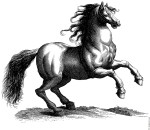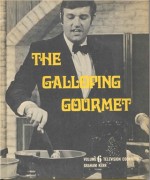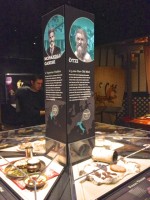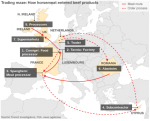The Third Wave for Food
Reply
Steve Case’s new book, The Third Wave, describes how a “third” wave of Internet innovation will dramatically change innovation in the coming decades.
According to Case, the first wave occurred between 1985 and 1999 when the Internet became almost ubiquitous. During the second wave, beginning in 2000 and ending in 2015, apps appeared, adding ecommerce and Internet entrepreneurs a platform for startups. Now, the rise of the third wave, as Case sees it, is the era of the Internet of Things when Read more [...]
 George Huntington Hartford and George Gilman, 19th century entrepreneurs, would flinch at this week’s news that the A & P grocery store chain was filing for bankruptcy. The two Georges created the iconic grocery chain in 1859 and built what we now know as the grocery supermarket. They developed the model for grocery stores that sell low-priced food across the U.S. Now, for the second time in ten years, the beleaguered company has less than 300 stores, down from the 16,000 it operated in
George Huntington Hartford and George Gilman, 19th century entrepreneurs, would flinch at this week’s news that the A & P grocery store chain was filing for bankruptcy. The two Georges created the iconic grocery chain in 1859 and built what we now know as the grocery supermarket. They developed the model for grocery stores that sell low-priced food across the U.S. Now, for the second time in ten years, the beleaguered company has less than 300 stores, down from the 16,000 it operated in  What does a remote Norwegian island 800 miles from the North Pole have to do with our food supply? Much more than you may think. Dr. Cary Fowler, speaking at the American Livestock Breeds Conservancy’s (ALBC) Annual Conference last week in Austin, Texas, explained how the Svalbard Global Seed Vault will protect global crop diversity for the next few millennia. Rarely covered by media and or included in the public debate about our food system, these genetics preservationists are vital to the sustainability
What does a remote Norwegian island 800 miles from the North Pole have to do with our food supply? Much more than you may think. Dr. Cary Fowler, speaking at the American Livestock Breeds Conservancy’s (ALBC) Annual Conference last week in Austin, Texas, explained how the Svalbard Global Seed Vault will protect global crop diversity for the next few millennia. Rarely covered by media and or included in the public debate about our food system, these genetics preservationists are vital to the sustainability  In 1859, The Curiosities of Food was published in London by Peter Lund Simmonds. Simmonds joined other Londoners at that time, such as George Dodd, author of The Food of London, in a quest to understand food at home and abroad. By then, four hundred million people had been added to the British Empire, each nation bringing a food culture that seemed exotic to the ordinary Victorian. Simmonds wrote the first truly global account of food, one that reflected a fascination with all things foreign.
Following
In 1859, The Curiosities of Food was published in London by Peter Lund Simmonds. Simmonds joined other Londoners at that time, such as George Dodd, author of The Food of London, in a quest to understand food at home and abroad. By then, four hundred million people had been added to the British Empire, each nation bringing a food culture that seemed exotic to the ordinary Victorian. Simmonds wrote the first truly global account of food, one that reflected a fascination with all things foreign.
Following  At a recent gathering in downtown Austin, the breakfast fare said it all. Organic yogurt, locally produced honey, fresh breakfast tacos broke from the usual offerings of croissants and Danish pastries. This crowd was invested in their food, mostly emotionally, some economically, as farmers, chefs, city planners, food activists, non-profits, and individuals gathered to learn about the possibility of a public food market in Austin.
Austin has farmers markets but no public market, yet. And even the
At a recent gathering in downtown Austin, the breakfast fare said it all. Organic yogurt, locally produced honey, fresh breakfast tacos broke from the usual offerings of croissants and Danish pastries. This crowd was invested in their food, mostly emotionally, some economically, as farmers, chefs, city planners, food activists, non-profits, and individuals gathered to learn about the possibility of a public food market in Austin.
Austin has farmers markets but no public market, yet. And even the  While the world watches Syria cross red lines, Syrians contend with breadlines. Hardly a grenade passes through rebel or military hands without making an impact upon the country’s food supply. Collateral damage inflicted on crops and animals rarely reaches consumers of news about the Syrian crisis.
Throughout history, governments have recognized the link between war, food, and national security. The Romans noticed the connection when they sought food sources throughout their empire; the French
While the world watches Syria cross red lines, Syrians contend with breadlines. Hardly a grenade passes through rebel or military hands without making an impact upon the country’s food supply. Collateral damage inflicted on crops and animals rarely reaches consumers of news about the Syrian crisis.
Throughout history, governments have recognized the link between war, food, and national security. The Romans noticed the connection when they sought food sources throughout their empire; the French  Graham Kerr. The Galloping Gourmet. The man and his brand are inseparable for most of us who got a taste of food programs on TV during the 1960s. Mr. Kerr first appeared on what was known as “experimental TV” on April 16, 1960, before the acclaimed Julia Child made her debut as The French Chef in 1963. But even before the two appeared on TV, Marcel Boulestin, a French chef living in England, appeared on the experimental television programs produced by the BBC during the 1930s. In January
Graham Kerr. The Galloping Gourmet. The man and his brand are inseparable for most of us who got a taste of food programs on TV during the 1960s. Mr. Kerr first appeared on what was known as “experimental TV” on April 16, 1960, before the acclaimed Julia Child made her debut as The French Chef in 1963. But even before the two appeared on TV, Marcel Boulestin, a French chef living in England, appeared on the experimental television programs produced by the BBC during the 1930s. In January  Some things are best left unsaid, and my experience as a pig cloner comes up in conversations only to cause nervous twitching on the part of my listeners. “How”, they wonder, “could someone dedicated to conservation and the environment wander off into the black art of biotechnology?”
During the years when I was raising heritage breeds of livestock in Maine, I found that one of our precious swine bloodlines was drying up. The farm, founded for the purpose of conserving rare breeds of livestock,
Some things are best left unsaid, and my experience as a pig cloner comes up in conversations only to cause nervous twitching on the part of my listeners. “How”, they wonder, “could someone dedicated to conservation and the environment wander off into the black art of biotechnology?”
During the years when I was raising heritage breeds of livestock in Maine, I found that one of our precious swine bloodlines was drying up. The farm, founded for the purpose of conserving rare breeds of livestock,  I recently visited the new exhibit at The American Museum of Natural History in New York called Our Global Kitchen, Food, Nature, Culture. As more and more Americans learn about their food, they can now feast on a museum exhibit that attempts to tell the whole story.
To tackle food as a broad subject is to launch upon a vast ocean in a small barque amidst thousands of hidden reefs. Topics such as genetic modification of foods lurk beneath the surface of most conversations about food. But this
I recently visited the new exhibit at The American Museum of Natural History in New York called Our Global Kitchen, Food, Nature, Culture. As more and more Americans learn about their food, they can now feast on a museum exhibit that attempts to tell the whole story.
To tackle food as a broad subject is to launch upon a vast ocean in a small barque amidst thousands of hidden reefs. Topics such as genetic modification of foods lurk beneath the surface of most conversations about food. But this  The daily revelations emerging from the discovery of horsemeat in lasagna purchased in Ireland reveal the complexities of our food system. When EU health commissioners tracked down the source of the horsemeat, they found a trail that passed through multiple countries, processors, dealers, brokers, Romania, England, Cyprus, Poland, the Netherlands, and in some cases, through illegal hands.
Since much of our meat is processed, ground up, blended with flavorings, shaped into meatballs and stuffed into
The daily revelations emerging from the discovery of horsemeat in lasagna purchased in Ireland reveal the complexities of our food system. When EU health commissioners tracked down the source of the horsemeat, they found a trail that passed through multiple countries, processors, dealers, brokers, Romania, England, Cyprus, Poland, the Netherlands, and in some cases, through illegal hands.
Since much of our meat is processed, ground up, blended with flavorings, shaped into meatballs and stuffed into